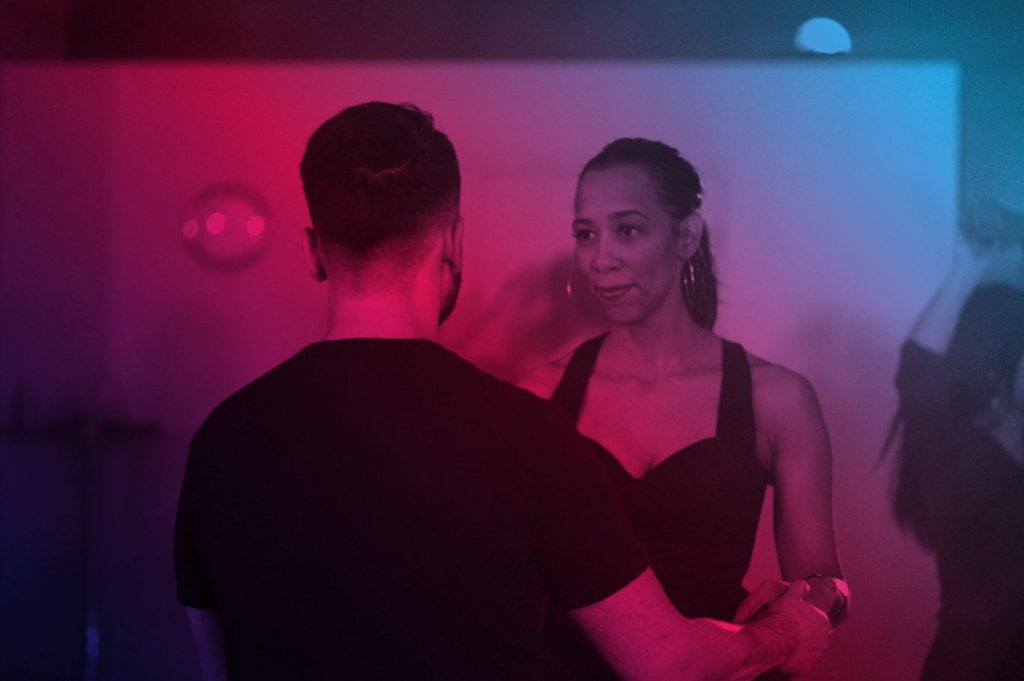Colombian Style Salsa (Cumbia)
Colombian style salsa began in Colombia and is danced to a different type of salsa music called “Cumbia” which is similar to the salsa rhythm but has a longer pause between the first three and the last three beats. It is rare to find a Cumbia instructional class as most people who dance this style were taught by family and friends. The style is still quite popular in South/Latin America and can be distinguished by a circular style of open/side breaks with a tap on the pauses of 4 and 8. Feet never move forward and backwards as in the Mambo step. Instead, the movement is a series of back to centre or side to centre footsteps. The style has very little turn patterns and is generally not a fast or “showy” style. Instead most Cumbia dancers will hold their partner very close with their entire bodies touching from head to toe. If turns are involved, they are generally very simple rock step left turns.
Cuban Style Salsa
Cuban salsa style is most similar to the original form of salsa rooted in Cuba . It is characterized by Afro Cuban style body movement which includes body isolation and hip movement. Cuban style salsa does not have many fast spins. Instead the movement is very circular as opposed to linear and partners tend to travel around each other. The hip movement is more noticeable in this style and stems from the pumping of the knees. The footwork is quite simple – the complexity lies in the arm work which requires the follower to have limber, flexible arms. Cuban style salsa is considered “male dominated” in the sense that the leader tends to be more showy and will create a greater push/pull feel for the follower then many other styles. Most Cuban style dancers tap on the pauses which are on the 4 th and 8 th beats if the dancers dance on 1. However, Cuban style salsa dancers do not always stay on the 1 beat and tend to stray depending on where the music takes them.
Miami Style Salsa (Classico Cubano, Casino)
Miami style salsa evolved from the Cuban style of salsa but is a more difficult and technically advanced style of Cuban salsa. Advanced Miami salsa moves tend to be intricate and pretzel-like and require a flexible follower to execute the moves. Many of the Miami moves are the same as Casino Rueda moves and the style is still more circular than linear. Open breaks or the Guapea basic (leader and follower break back and then push off eachother) with a tap are the most common basic steps in Miami style salsa. Cross body lead variations are common but are executed in a more circular fashion.
Casino Rueda Style Salsa (Rueda de Casino, Salsa Rueda)
Casino Rueda (meaning salsa wheel) is a group dance which originated in Havana , Cuba in the 1960s by a group called Guaracheros de Regla. In this dance, couples dance in a circle while one dancer, designated as “The Caller”, provides hand signals or calls out the moves which will be executed by every couple in the circle simultaneously. Many of the Casino moves involve swapping or switching partners which makes the dance tricky to execute and spectacular to watch. Rueda is very popular in Cuba and Miami and has gained popularity all over the world. Cuban Rueda tends to be more playful with easy-to-follow fun moves while Miami Rueda has many complicated turn patterns and requires memorization and skill to execute. Many callers will know anywhere from 150-300 moves so memory, speed and accuracy is a key to ensuring the circle is not broken. The advantage of learning Casino Rueda is that all moves learned in the Rueda circle can be danced one on one with a partner adding to a dancer’s repertoire of moves.
L.A. Style Salsa (Dancing “On 1”)
L.A. style salsa, usually danced “On 1”, is a flashier version of New York style salsa moves. Dancers use lots of dips, flips, drops and tricks which make for a great show to watch. The back and forth Mambo basic, again in a linear motion, is utilized with the leader breaking forward on 1. Because the dominating beat is the 1 beat which is the most accented beat in the series, the dancing looks and feels powerful and fast. L.A. style salsa has incorporated many other types of dancing including jazz, hip hop, and ballroom which is challenging for the dancers and entertaining for the viewers. Similar to the New York style salsa, many of the moves are created from cross-body lead variations. Shines are an important component of this type of salsa with complicated, speedy footwork and jazzy moves.
New York Style Salsa (Dancing “On 2”, Mambo Salsa, Eddie Torres Style)
Salsa on 2, commonly referred to as “Mambo”, is a style of salsa first introduced by Eddie Torres in New York in the 1960s. Technically speaking, dancing “On 2” refers to the beat the dancers break forward on. Followers will break forward with the left foot on the 2 and leaders will break forward on the 6. New York style salsa is distinguished by smooth, controlled, highly technical movements that are elegant, graceful, flow well and are not rushed. The style is very linear and many of the turn patterns evolve from cross body lead variations. Multiple spins, complicated footwork, Afro Cuban body movement and shines are a must. Dancing “On 2” is rhythmically more difficult as it is easier to hear the 1 beat and break on this beat. Many dancers learn to dance “On 1” first and then train “On 2” as they feel it is more musically and rhythmically rich and complex.
Puerto Rican Style Salsa
Puerto Rican style salsa can be danced “On 1” or “On 2”. If you are dancing Puerto Rican style “On 2” dancing, it is opposite from New York style in the sense that the leader breaks forward on 2 instead of the follower (can be called “On 6”). Some say that shines originated in Puerto Rico as these dancers would break away from their partners and execute extremely fast and complicated solo footwork. The lines are very clean and there is a great deal of shoulder shimmies incorporated into the dancing. There is an emphasis on dancing to the “Clave” especially the 2/3 clave (pa-pa, pa-pa-pa). In fact Felipe Polanco, one of the pioneers of Puerto Rican salsa, has created a unique basic that complements the uneven 5 beat dance which incorporates a sliding forward and back motion that hits the accents of the clave.
Salsa Shines
Shines refer to solo work when the leader breaks away from the follower and each dancer has the opportunity to freestyle on their own to the rhythm and accents of the salsa music. Shines involve more complex footwork as well as body movement and arm work. Shines are common in the New York , L.A. and Puerto Rican styles of dancing. They are not as common in the Cuban, Miami and Colombia styles of dancing. The term “shines” originally referred to having the opportunity to “shine” independently. Shines give dancers an opportunity to take a break from partner work and turn patterns and freestyle. There are many common shines such as Suzy Qs and flares but every dancer has their own unique and individual movements which allows dancers to be constantly challenged.
Salsa Styling
Incorporating styling techniques into any style of salsa has become very common. For both men and women shines, leg work, arm work, body movement, spins, body isolations, shoulder shimmies and rolls, and even hand styling have become a huge trend in the salsa scene. There are lessons dedicated to the art of salsa stylin’. Hip hop, jazz, flamenco, belly dancing, ballroom, breakdancing/pop and lock, and Afro Cuban styles have all been infused into the art of styling.


